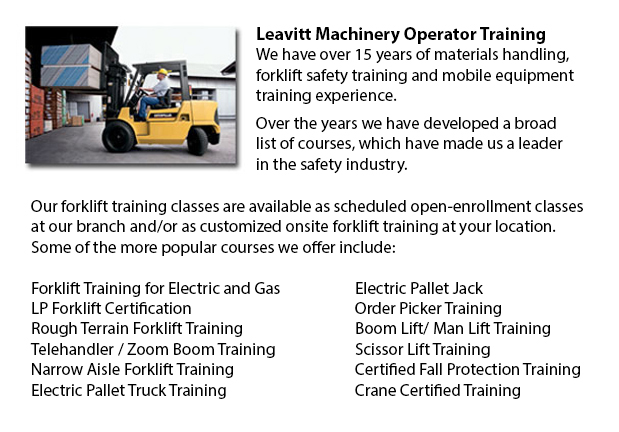
Rough Terrain Forklifts Training Mississauga - There are actually two unique kinds of forklifts within the materials handling industry, the industrial model and the rough terrain model. Rough terrain forklifts initially came on the marketplace in the 1940's and were predominantly utilized on uneven roads, ideal for areas where no paved roads were accessible, like building sites and lumberyards.
Typically, nearly all rough terrain forklifts are run on a propane, diesel or gasoline powered internal combustion engines with a battery used for power. Several suppliers are experimenting with rough land forklifts that utilize vegetable matter and run from ethanol. Large pneumatic tires with deep treads typify these forklifts to permit them to clutch onto the roughest soil type without any slippage or drifting.
A few of the original designs of rough terrain lift trucks had the capability to raise in excess of 1000 lbs, using forks that could run underneath the item, jack it slightly and move it to a different location. After ten years on the market, rough terrain forklifts were augmented with additional hauling muscle, increasing the potential cargo to more than 2000 lbs. Telescoping booms were added in the 1960's, allowing them to stack supplies a good deal higher than in previous years. The telescoping design characteristic is a staple of most all terrain lift trucks nowadays. Present designs are capable of handling well over 4000 lbs due to the continued enhancements over the years. Telescoping capability has also improved with some models reaching a height of 35 feet. Worker safety has also become a focus with a lot of rough terrain forklifts now designed are outfitted with an enclosed cab for the driver, as opposed to the older open air seating capacity.
The all terrain lift trucks on the market today both run well on unpaved roads and paved floors. This kind of all terrain lift truck is marketed for its' flexibility allowing the opportunity for establishments to utilize one unit to carry supplies from an outside working area into a warehouse.
-
Komatsu Forklift
Komatsu Forklift Training Mississauga - Komatsu Forklift U.S.A. Inc., an associate of the Komatsu Ltd. family, has an encouraging reputation for building robust and dependable forklifts. They are renowned worldwide as a business who has a proud herit... More -
Boom Trucks
Boom Trucks Training Mississauga - Boom truck are often used by phone, cable and utilities organizations as they have extended folded arms which are generally folded over the roofs of business vehicles. On the end of the extension of extendable arms... More -
Pallet Lifts
Pallet Lifts Training Mississauga - A pallet lift is equipment designed in particular for moving pallets of irregular weights and sizes. They can be utilized in conjunction with cranes, forklifts and other heavy duty equipment as an attachment piece... More -
Pallet Stackers
Pallet Stackers Training Mississauga - Pallet stackers are a type of pallet jack that might be used to stack, transfer and lift goods positioned on a pallet that are far too burdensome for physical lifting. Mostly these mechanisms are employed to loa... More -
Scissor Pallet Trucks
Scissor Pallet Truck Training Mississauga - Scissor lift pallet vehicles are made to be able to rearrange and stack pallets with an integrated raising apparatus that enables the pallets to be elevated. This apparatus is incredibly effective for worki... More

Forklift Certification Mississauga
TOLL FREE: 1-888-254-6157
Mississauga, Ontario
forkliftcertificationmississauga.com
Email Us
About Us


